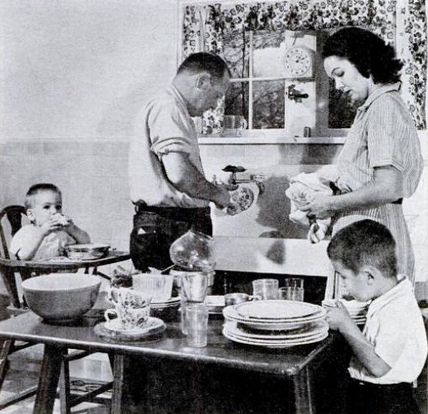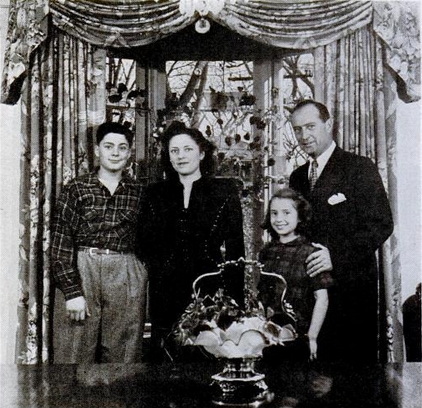I found this 1946 Life Magazine article while searching for vintage Kansas photos (the article features a farmer from Shawnee County, KS and a future post is forthcoming). We frequently hear about the way it used to be, stable middle class of the past, high taxes on the wealthy and many other economic and cultural realities that were lost over the past 60 years. The article briefly touches on several segments of the post-war society, their roles in the economy and their material well-being. The language of the article is strikingly similar to what we see in the media today. Over time, the classes described in the article were redefined or disappeared; rich people are not content with just two Cadillac’s; no one is paying two thirds of their income in taxes; and $12,000 a year does not equate to being successful. There is one notable exception: the teachers are still being screwed. Anyway, the article is short, enjoy.
The redistribution of U.S. Wealth
Taxes, unions and higher prices are making the man with a large income Poorer and the poorer man richer.
Published in the Life Magazine December 16, 1946 p91.

Huey Long’s old cry “share the wealth,” a political catchword of the early ‘30s, has long since been forgotten. Yet, though few Americans realize it, they have just gone through a social revolution which has redistributed the wealth to an amazing extent. The instruments of this revolution have been the war, which brought a fantastic increase in income taxes and prices, and the labor union. The beneficiaries have been the farmer and the union member. The losers have been the wealthy, the upper middle classes and above all white-collar worker who lives on a relatively fixed salary.
The change in the average factory worker’s lot is shown in the photographic chart above, based on recent Bureau of Labor Statistics figures. In 1936 her earned $1,133. Food, clothing, housing, utilities and furnishings for his family of four cost him $861 a year. His miscellaneous expenses, including a modest allowance for pleasure, were $297. Though the only federal tax he paid was social security, he finished the year with a deficit of $37. Today his income is $2,230. The same food, clothing, housing, utilities and furniture cost him $$1,278. The same miscellaneous services cost $401. But he still pays only social-security tax plus a mere $3 in federal income tax. Thus he has $526 left to spend on raising his living standard in any way he sees fit. But since prices have risen about 45%, his $525 is worth about $363 in 1936 terms – which means that he is 35% better off than in 1936.
But a white-collar man whose income has remained $4,000 has lost much of his buying power. If he has two children, his income tax has risen from zero to $108 and inflation has cost him $1,145. Since taxes get progressively steeper, the financial decline of the high-salaried man is even more startling. A $10,000 income today is worth only $6,550 prewar, a $20,000 income worth $11,000, a $50,000 income worth $22,000. Below are some examples of how the redistribution of “real income” has affected American families.
A factory worker has gained 100%.
In 1936 Horace Castle, shown above with his wife and three children, went to work for the Carnegie-Illinois Steel Corp. in Chicago as an unskilled laborer at $18.80 a week. Now, with a better job with wage increases won by the United Steelworkers, he makes $53.60 a week. Since family exemptions put him below the income tax minimum, his purchasing power is double what it was in 1936 even allowing for the increase in prices. He bought his house for $3,300 in 1943, figures it is worth $6,500 today and expects to own it mortgage-free by 1951.
Famer gets five times more cash.
Because they sell more than they buy, farmers like Charles Todd Jr. of Shawnee County, Kan. (above) has profited rather than lost from high prices. In 1936 Todd’s net cash income from 80 acres was $579. The war boom enabled him to buy an additional 147 acres. This year he estimates that his cash net income will be $3,200, which amounts to some $2,200 by prewar standards. This is over and above the food and shelter that his farm provides. Because four children cut his income taxes to $71, he figures that he will put about $2,000 into savings.
Schoolteacher feels the pinch.
Milton D. Phillips of Freeport Ill. (above) is in the plight of the most middle-class white-collar workers whose incomes have not kept pace with the rapid rise in prices. By teaching manual training and coaching athletic teams in the Freeport Schools and by selling books during the summer vacation, he earns $3,600 a year. He budgets only $72 a year for recreation and $108 for savings. His wife does her own washing and their family car is a 1936 model which has gone 115,000 miles.
$12,000 a year buys few luxuries.

Warren B.Fuller of Stamford, Conn. (above) belongs to a class whose members would never have thought of doing their own housework 10 years ago. At 37 he is a successful young shipbuilding executive and earns $12,000 a year. But income taxes take $2,100 and the purchasing power of the remainder is only $6,900 by prewar standards. Mrs. Fuller feels she cannot afford a maid at present rates and cuts the two children’s hair herself to save the $1 barber’s fee. Their chief luxuries are one evening in New York a month, and a new automobile.
A big businessman is retrenching.

Willard Cole has $17,000 house, one maid, a part-time gardener.
Before the war and higher taxes Willard W. Cole (above), a department-store executive in Chicago, was building up a modest fortune. Now, though he makes $36,000 a year in salary and even more from investments, he pays to thirds of his income in taxes, uses most of the rest to maintain his suburban home and quiet social life. Since he always lived modestly considering the size of his income, his chief retrenchment is in savings. Many in same bracket who lived more luxuriously and saved less have had to sell their mansions to cut fixed expenses.
A few are new-rich despite taxes.
At present price and tax level, few young men starting from scratch can ever hope to own swimming pools and even dine in the Stork Club without worrying about the check. The only recent exceptions, aside from black marketeers, have been in war industries and entertainment. A prime example is John Guedel (above), who was cleaning sewers in Beverly Hills 10 years ago. Then he got into radio, invented the People Are Funny show. Now he makes $250,000 a year, despite heavy taxes owns two Cadillacs and Movie Actor Keenan Wynn’s former home.